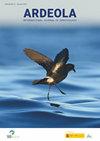非洲波状衣原体的兰萨罗特岛种群:人口普查、性别比例、生产力和一种新的调查方法
IF 1.2
4区 生物学
Q2 ORNITHOLOGY
引用次数: 11
摘要
兰萨罗特岛位于加那利群岛,是非洲胡巴拉鸨的加那利亚种波状衣原体的主要据点。近几十年来,根据在小样本地区获得的鸟类密度外推,对该种群的规模进行了多次估计。在这里,我们展示了基于汽车样带结合频繁和长时间扫描的基础上,在2018年1月至2月的交配季节对该岛的后原种群进行的第一次完整普查的结果。根据对370只鸟(雄性161只,雌性209只)的统计,我们估计岛上总共有440-452只后原鸨。首次获得了该物种的性别比:1.41雌性对雄性。记录了3年的年幼鱼产量,每100只雌鱼的产量在5.83到19.57之间。本研究中使用的人口普查方法被提议作为以前使用的线样条的替代方法,因为它避免了可能高估人口的方法缺陷。目前的方法还可以确定性别比例和生产力,并确定了大多数展示雄性的位置。这些是评估非洲胡原濒危亚种的保护状况和繁殖性能的重要参数。——阿隆索,j.c.,帕拉辛,C.和阿伯里尔-科隆,I.(2020)。非洲波状衣原体的兰萨罗特种群:人口普查、性别比例、生产力和一种拟议的新调查方法。Ardeola, 67: XX-XX。本文章由计算机程序翻译,如有差异,请以英文原文为准。
The Lanzarote Population of the African Houbara Chlamydotis undulata fuertaventurae: Census, Sex Ratio, Productivity, and a Proposed New Survey Method
Lanzarote island, in the Canary archipelago, is the main stronghold of the Canarian subspecies of the African Houbara Bustard Chlamydotis undulata fuertaventurae. The size of this population has been estimated several times in recent decades, based on extrapolations of bird densities obtained in small sampling areas. Here we present the results of the first complete census of the Houbara population of this island, based on car transects combined with frequent and prolonged scanning stops, and carried out during the mating season, in January-February 2018. Based on a count of 370 birds (161 males, 209 females) we estimate a total population of 440-452 Houbara Bustards on the island. For the first time, a sex-ratio figure was obtained for this species: 1.41 females per male. The annual production of juveniles was recorded for three years and varied between 5.83 and 19.57 juveniles per hundred females. The census method used in this study is proposed as an alternative to the line transects used previously, since it avoids possible methodological flaws that probably overestimate the population. The present method also enables sex ratio and productivity to be determined, and it established the locations of most displaying males. These are important parameters for evaluating the conservation status and reproductive performance of this endangered subspecies of the African Houbara.—Alonso, J.C., Palacin, C. and Abril-Colon, I. (2020). The Lanzarote population of the African Houbara Chlamydotis undulata fuertaventurae: census, sex ratio, productivity, and a proposed new survey method. Ardeola, 67: XX-XX.
求助全文
通过发布文献求助,成功后即可免费获取论文全文。
去求助
来源期刊
CiteScore
2.30
自引率
6.20%
发文量
16
审稿时长
>12 weeks
期刊介绍:
Ardeola: International Journal of Ornithology is the scientific journal of SEO/BirdLife, the Spanish Ornithological Society. The journal had a regional focus when it was first published, in 1954. Since then, and particular during the past two decades, the journal has expanded its thematic and geographical scope. It is now a fully international forum for research on all aspects of ornithology. We thus welcome studies within the fields of basic biology, ecology, behaviour, conservation and biogeography, especially those arising from hypothesis-based research. Although we have a long publication history of Mediterranean and Neotropical studies, we accept papers on investigations worldwide.
Each volume of Ardeola has two parts, published annually in January and July. The main body of each issue comprises full-length original articles (Papersand Review articles) and shorter notes on methodology or stimulating findings (Short Communications). The publication language is English, with summaries, figure legends and table captions also in Spanish. Ardeolaalso publishes critical Book Reviewsand PhD-Dissertation Summaries; summarising ornithological theses defended in Spain. Finally there are two Spanish-language sections, Ornithological News; summarising significant recent observations of birds in Spain, and Observations of Rare Birds in Spain, the annual reports of the Spanish Rarities Committee.

 求助内容:
求助内容: 应助结果提醒方式:
应助结果提醒方式:


